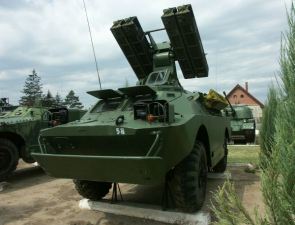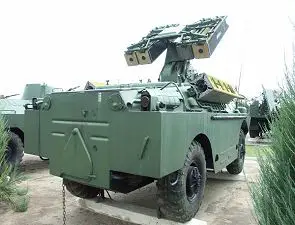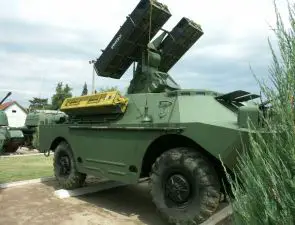|
| |
|
|
| |
| Description |
|
The SA-9 Gaskin (Russian designation 9K31 Strela-1) is a highly mobile, short-range, low-altitude infrared-guided surface-to-air missile system mounted on the wheeled armoured vehicle BRDM-2. The first Strela-1 (SA-9/`Gaskin') launchers were produced in 1966, with the system attaining operational status in 1968.
|
| |
|
Variants :
|
|
- TABC-79: Romanian version, the missiles are mounted on a local chassis
|
|
|
|
|
|
|
|
| Armament |
|
The system consists of a 9P31 BRDM-2 based Transporter-Erector-Launcher (TEL) with the normal turret and chain-driven belly wheels removed and replaced by a turret with four ready to launch SA-9 container-launcher boxes. Reloading is performed manually and usually takes approximately 5 minutes. The missile boxes are lowered for transport to lower the total height of the vehicle. The driver and commander have periscopes for viewing outside the vehicle when the hatches are closed.The missiles fold down to the sides of the turret which greatly reduces the height of the vehicle whilst travelling.
|
| Missile |
|
The original version of the Strela-1 missile was known as the 9M31 (`Gaskin' Mod 0) and used a 9E41 uncooled first-generation lead sulphide (PbS) infra-red seeker operating in the 1 to 3 µm waveband region. This was supplemented by the 9M31M variant (Strela-1M/SA-9b/`Gaskin' Mod 1) which entered service in 1970 and has an improved 9E41 PbS seeker operating in the 1 to 5 µm waveband region to provide greater target sensitivity and lock on ability. When engaging a head-on target the system has a considerably reduced range. The SA-9 is fitted with a 3 kg HE fragmentation warhead and proximity fuze. The warhead has a lethal radius of 5 m and damage radius of 7.6 m.
|
| Accessories |
|
The driver and commander both have infra-red vision systems. The vehicle has standard NBC (Nuclear, Biological and Chemical) protection including overpressure.
|
| Command and control radar |
|
One SA-9 TEL, usually the battery commander, (SA-9 Mod A, BRDM-2A1 or SA-9A TEL) in each battery has been fitted with 9S16 Flat Box-A. The Flat Box A is a radar detection antenna, one is fitted either side of the hull above the front wheel housings, one under the left launch canisters pointing forward and one mounted on a small frame above the rear engine deck plate pointing rearwards. The azimuth scan sector for the system is 360º, the elevation capability 40º and the maximum detection range 30 km. The BTR-60PU-12 command vehicle of the Strela-1 unit is usually alerted by the Divisional Air Defence Regiment's command post as to a potential target's azimuth, range and altitude. This information is assessed with additional data from the unit's own visual observer network and any microwave transmissions picked up by the Strela-1 `Flat Box' TEL. The commander then instructs the unit as to which target should be engaged by which vehicle and orders the engagement(s) to commence.
|
| Combat use |
|
The Strela-1 was deployed in short-range air defence batteries of Soviet motor rifle and tank regiments. The battery consisted of a gun platoon of four ZSU-23-4 Shilkas, and a SAM platoon with four Strela-1 vehicles. In combat the missiles are usually sequentially fired (two per target) to increase the kill probability with a time between rounds of about 5 seconds. Reloading is performed manually and takes about 5 minutes to accomplish. Operating in the visual and near IR regions the Strela-1 can home in on any air target from any direction in daytime since its tracking ability relies on a contrast (either positive or negative) with the background.
|
| |
| Specifications |
|
|
| |
|
Armament
|
|
4 × SA-9 missiles
|
|
Country users
|
|
Algeria, Angola, Armenia, Benin, Bulgaria, Czech Republic, Cuba, Croatia, Bosnia and Herzegovina, Egypt, Ethiopia, Hungary, India, Iraq, Libya, Mongolia, Mozambique, Nicaragua, Poland, Romania, Russia, Serbia, Slovenia, Syria, Uganda, Ukraine, Uzbekistan, Vietnam, Yemen
|
|
Guidance
|
|
(9M31) 1-3 µm waveband uncooled PbS passive IR homing seeker
(9M31M) 1-5 µm waveband cooled PbS passive IR homing seeker
|
|
Warhead
|
|
3 kg HE fragmentation with contact and proximity fuzing
|
|
Crew
|
|
3 (commander, gunner and driver)
|
|
|
Armour vehicle
|
|
5 - 14 mm
|
|
Effective range and altitude
|
|
Range:
(9M31) 1,000 - 4,200 m
(9M31M) 500 - 4,200 m
Altitude:
(9M31) 50 - 3,000 m
(9M31M) 30 - 3,500 m
|
|
Radar
|
|
Flat Box A radar detection antenna
a
a
a
|
|
Combat Weight vehicle
|
|
7,000 kg
a
|
|
Dimensions vehicle (on road)
|
|
Lenght, 5,8 m; Width, 2,4 m; Height, 2,3 m
|
|
|
|
|
|
|
| |
|
|
|
|
|

































